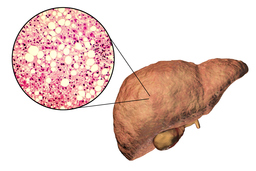Polygenic Markers of Hepatic Steatosis and Cirrhosis
TECHNOLOGY NUMBER: 2021-461
Tags:

OVERVIEW
Novel genetic loci that correlate with formation of nonalcoholic fatty liver disease (NAFLD)- Provides insight into NAFLD pathogenesis and defines specific disease subtypes
- Creates genetic marker panels that can identify at risk individuals and guide therapy
MODALITY
Genetic testing through biospecimen analysis (e.g., blood or saliva)
INDICATION
Nonalcoholic fatty liver disease (NAFLD) and progression risk to advanced liver conditions (e.g., cirrhosis, hepatocellular carcinoma)
PUBLICATIONS
INTELLECTUAL PROPERTY
Patent pending
BACKGROUND
Nonalcoholic fatty liver disease (NAFLD) is a heritable and prevalent disease that has no effective treatments. NAFLD is caused by the deposition of excess fat in the liver and can lead to advanced liver diseases such as inflammation, fibrosis or cirrhosis, and hepatocellar carcinoma. The increased prevalence of obesity in developed countries has correlated with an increasing incidence of NAFLD. Greater than 90% of severely obese patients suffer from NAFLD, and their average lifespans are correspondingly shorter than non-obese subjects. Furthermore, while a causal relationship has not been proven, the presence of NAFLD corresponds to higher rates of dyslipidemia, hypertension, cardiovascular disease, and diabetes mellitus. NAFLD is on pace to become the most common cause for liver transplantation in the United States, causing a great personal burden for patients and significant economic strain on the healthcare system. A need therefore exists to identify genetic variants which could provide early identification of and treatment for NAFLD.
INNOVATION
Researchers at the University of Michigan have identified genetic loci that predispose for the development of fatty liver diseases which are unrelated to alcohol intake. The scientists carried out a genome-wide meta-analysis of patients with nonalcoholic fatty liver disease (NAFLD) patients identified by imaging studies and medical diagnostic codes to reproducibly define the associations of genetic variations with this condition. The investigators identified 11 NAFLD associated variants, and they showed that the presence of these traits is more capable of predicting the onset of NAFLD than are measures of standard liver function tests. These markers permit further identification of susceptible individuals, classifies them into disease subtypes, and links them to the most appropriate treatments, irrespective of ancestry or gender. The information gained from these investigations can also aid in identification of patients at risk for suffering cirrhosis and hepatocellular carcinoma.